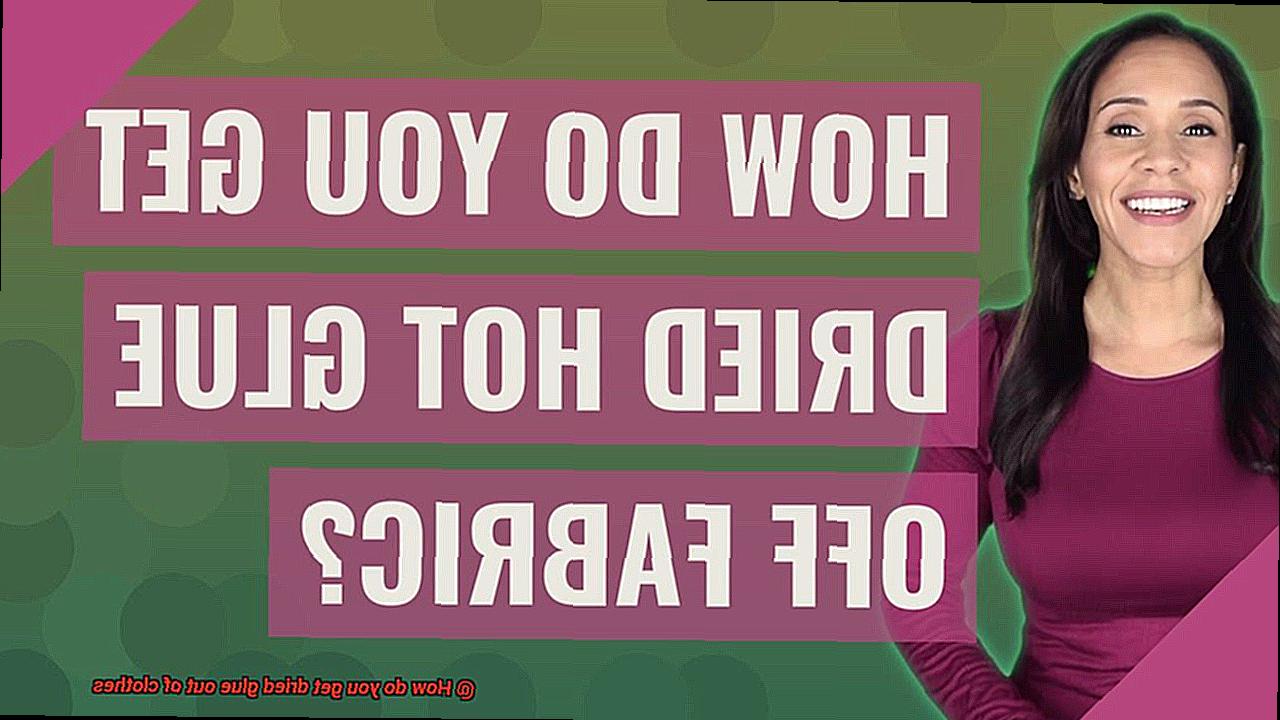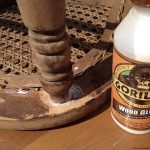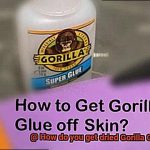Picture this: you’re rocking your favorite shirt, feeling like a fashion icon, when suddenly disaster strikes. You accidentally brush up against some sticky glue, and before you know it, your beloved garment is marred by an unsightly stain. Cue the sighs of despair and the frantic Google searches for a solution.
But fear not. Today, we’re diving headfirst into the epic battle against dried glue stains on clothes. Consider this your ultimate guide, filled with tips and tricks to rid your wardrobe of these adhesive nightmares once and for all. Say goodbye to frustration and hello to a world where your clothes are free from gluey clutches.
We’ll explore everything from tried-and-true home remedies to powerful stain-fighting techniques tailored to different types of glue and fabric sensitivities. So roll up those sleeves and get ready to embark on a journey that will restore your clothes to their former stain-free glory.
No more staring sadly at that ruined outfit in your closet – it’s time to unleash the true potential of your clothing. Let’s jump right into the captivating world of glue stain removal and reclaim your fashion confidence.
What is Glue?
Contents
Glue, the sticky and viscous substance that has been around for centuries, serves one primary purpose: to bond materials together. It may come in the form of a liquid or gel that hardens into a solid when it dries, creating a secure and durable connection. But what exactly is glue made of?
The ingredients in glue can vary depending on the type, but some common components include polymers, solvents, additives, and fillers. These ingredients work together to create a formula that is suitable for specific applications. For example, white glue is often used in crafting projects, while super glue is known for its quick-drying and strong bond.
Glue can be derived from either natural or synthetic sources. Natural glues have been used for centuries and are made from organic materials like animal bones, hide, or fish. These traditional glues are still used today in some traditional crafts and woodworking. On the other hand, synthetic glues are created through chemical processes using petroleum-based products.
Using glue is a straightforward process. You simply apply it to the surfaces you want to join together and allow it to dry. As it dries, the liquid or gel transforms into a solid state, forming a strong bond between the materials. The drying time depends on the type of glue and environmental conditions.
Glue finds its usefulness across various industries and applications. From crafting projects to woodworking and construction, glue provides a convenient alternative to mechanical fasteners like nails or screws. It is even used in packaging and medical applications like wound closure.
Types of Glue
With patience and the right method, even dried glue stains can be successfully removed from clothes.
Wood Glue
Wood glue, also known as carpenter’s glue, is specifically formulated for bonding wood materials together. It creates a strong bond that is resistant to moisture once fully cured. If wood glue accidentally gets on clothes, it can be challenging to remove due to its adhesive properties. Special solvents or stain removers may be required for effective removal.
Understanding the different types of glue can help determine the appropriate method for removing dried glue stains from clothes. It is important to note that some glues may require more specialized techniques or professional assistance for successful removal.
When dealing with dried glue stains on clothes, it is essential to approach the situation with caution. First, gently scrape off any excess glue using a dull knife or your fingernail. Be careful not to damage the fabric in the process. Then, depending on the type of glue involved, you can try one of the following methods:
For white glue and fabric glue
Soak the stained area in warm water for a few minutes to loosen the glue. Gently rub the fabric together to remove the softened glue. If any residue remains, apply a small amount of liquid detergent directly to the stained area and gently scrub with a soft brush or cloth. Rinse thoroughly with warm water.
For super glue
Apply a small amount of acetone or nail polish remover to an inconspicuous area of the fabric to test for colorfastness. If there is no color change or damage, apply the acetone or nail polish remover directly to the stain using a cotton ball or cloth. Blot, rather than rub, the stain to avoid spreading it further. Repeat this process until the stain is completely removed. Wash the fabric as usual.
– For epoxy glue
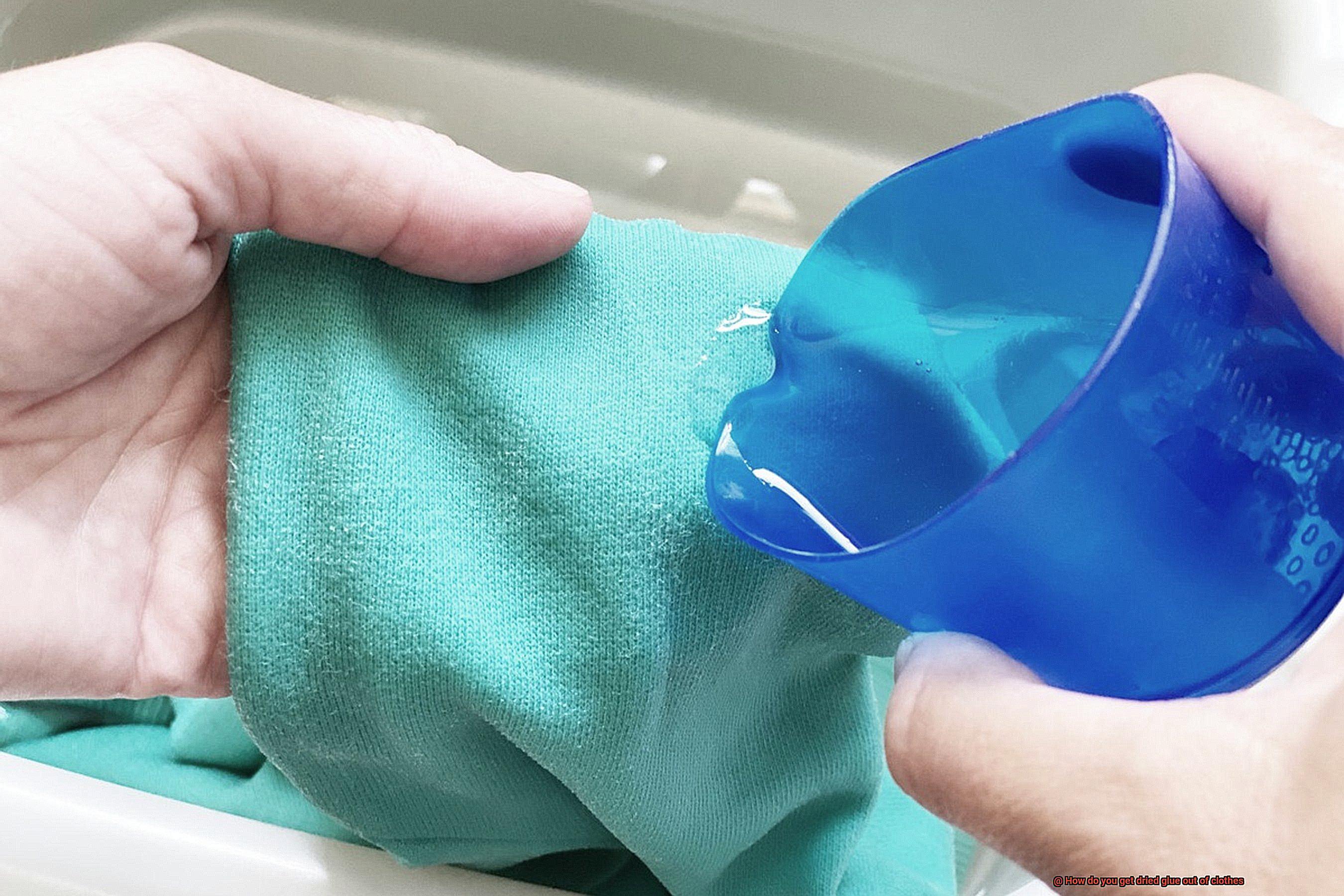
Soak the stained area in hot water for about 30 minutes to soften the glue. Gently rub the fabric together to remove the softened glue. If any residue remains, apply a commercial adhesive remover or stain remover to the stained area and follow the manufacturer’s instructions. Wash the fabric as usual.
– For hot glue
Allow the glue to cool and harden completely. Once hardened, gently peel or scrape off as much of the glue as possible using a dull knife or your fingernail. If any residue remains, place the fabric in the freezer for a few hours to make the glue brittle. Once frozen, gently scrape off the remaining glue. Wash the fabric as usual.
It is important to note that not all glues can be successfully removed from clothes, especially if they have already dried and set. In such cases, it may be best to consult a professional cleaner or tailor for assistance.
Why is it Important to Act Quickly?

Acting quickly can make all the difference when it comes to dealing with dried glue on clothes. It’s not just about getting rid of a sticky mess; there are several compelling reasons why taking immediate action is crucial.
First and foremost, acting quickly helps prevent further damage to the fabric. Glue has a sneaky way of hardening over time, making it more challenging to remove. If left untreated, dried glue can cause permanent stains or even damage the garment itself. By addressing the issue promptly, you can stop the glue from wreaking havoc on your clothes.
Another reason to act quickly is the ease of removal. Fresh glue is generally easier to remove compared to its dried counterpart. By acting promptly, you can take advantage of this window of opportunity and increase the chances of successfully getting the glue out of the clothes without leaving any residue behind. Don’t let the glue harden and set in; tackle it while it’s still fresh.
Stain prevention is yet another compelling reason to act quickly. Dried glue can leave unsightly stains on clothes, especially if it contains pigments or dyes. By acting promptly, you can minimize the risk of these stains setting into the fabric. This makes it easier to remove the glue and avoid any lasting discoloration that could ruin your favorite outfit.
In addition to preventing damage and stains, acting quickly also saves you time and effort in the long run. We all know that time is precious, and the longer you wait to address dried glue on clothes, the more time and energy it may take to remove it completely. By taking immediate action, you increase the likelihood of successful removal and save yourself from prolonged cleaning sessions.
Preserving the quality of your clothing is another crucial consideration. Acting promptly to remove dried glue helps maintain the overall quality of your garments and prolong their lifespan. By taking quick action, you reduce the chances of damaging the fabric or needing to resort to harsher cleaning methods that could potentially weaken or fade the garment. Your favorite clothes deserve some TLC, so don’t hesitate to give them the care they need.
Last but not least, acting quickly provides peace of mind. There’s nothing quite like the satisfaction of knowing you’ve tackled a problem head-on. By taking immediate action, you can address the issue before it becomes a bigger concern. Instead of stressing about a stained or damaged piece of clothing, you can act quickly and increase your chances of restoring the garment to its original condition. The peace of mind that comes with taking proactive steps is invaluable.
Scraping off Excess Glue
Scraping off excess glue from clothes is a delicate process that requires precision and the right tools. By following a step-by-step guide, you can effectively remove dried glue stains and salvage your garments. Here’s how to scrape off excess glue in an engaging and professional manner:
- Choose the right tool: Opt for a plastic spoon or a dull knife to scrape off excess glue. These gentle tools minimize the risk of tearing or damaging the fabric. Avoid sharp or metal objects that can cause further harm.
- Gently scrape off the glue: Start by gently scraping off as much dried glue as possible. Take it slow and steady, focusing on one area at a time. Applying too much pressure can push the glue deeper into the fabric or stretch it.
- Soften the glue if necessary: If the glue is stubborn or hardened, try softening it before scraping. Apply a warm, damp cloth or sponge to the area and let it sit for a few minutes. The warmth and moisture will help loosen the glue, making it easier to remove.
- Freeze the glue: For stubborn glue, freezing can be an effective method. Place an ice pack or a bag of ice cubes on top of the glue for several minutes to harden it. Once hardened, you can scrape it off more easily.
- Be patient and take your time: Patience is key when scraping off excess glue. Rushing or using excessive force can damage the fabric. Work gently and methodically, ensuring you remove as much glue as possible without causing harm.
Soaking in Warm Water
A glob of glue lands on your favorite shirt, leaving an unsightly stain. Panic sets in as you frantically search for a solution. Fear not, for soaking in warm water is here to save the day.
Soaking in warm water is a tried and true method for removing dried glue from clothes. The secret lies in the power of heat and moisture working together to loosen the stubborn adhesive. But how exactly does this magical process work? Let’s dive in.
First, gather your materials. Fill a basin or sink with warm water, ensuring it’s not too hot to handle. We don’t want any fabric casualties on our hands. If needed, prepare a small amount of gentle detergent or stain remover to aid in the battle against the glue.
Now comes the fun part – soaking the clothing. Carefully place the affected area into the warm water and let it bask in its warmth for at least 30 minutes. This generous soak allows the warm water to seep into the fabric and start breaking down the glue. For those extra stubborn stains, feel free to extend the soak time.
Once the glue has had its dose of relaxation, it’s time to assist with gentle rubbing. Gently rub the fabric together to further loosen the glue’s grip. A soft brush or toothbrush can also be enlisted for this task, providing a little extra scrubbing power. Remember, though, we want to treat our clothes with kindness – no rough handling that could damage those precious fibers.
After you’ve loosened the glue to your satisfaction, rinse thoroughly with clean water. This step ensures that no trace of glue remains, leaving your clothes pristine and ready for their next adventure.
If, despite your valiant efforts, the glue stain persists, don’t despair. You can repeat the soaking process or explore other methods mentioned in subsequent sections. Sometimes, these stubborn glue stains require multiple attempts to fully bid them farewell.
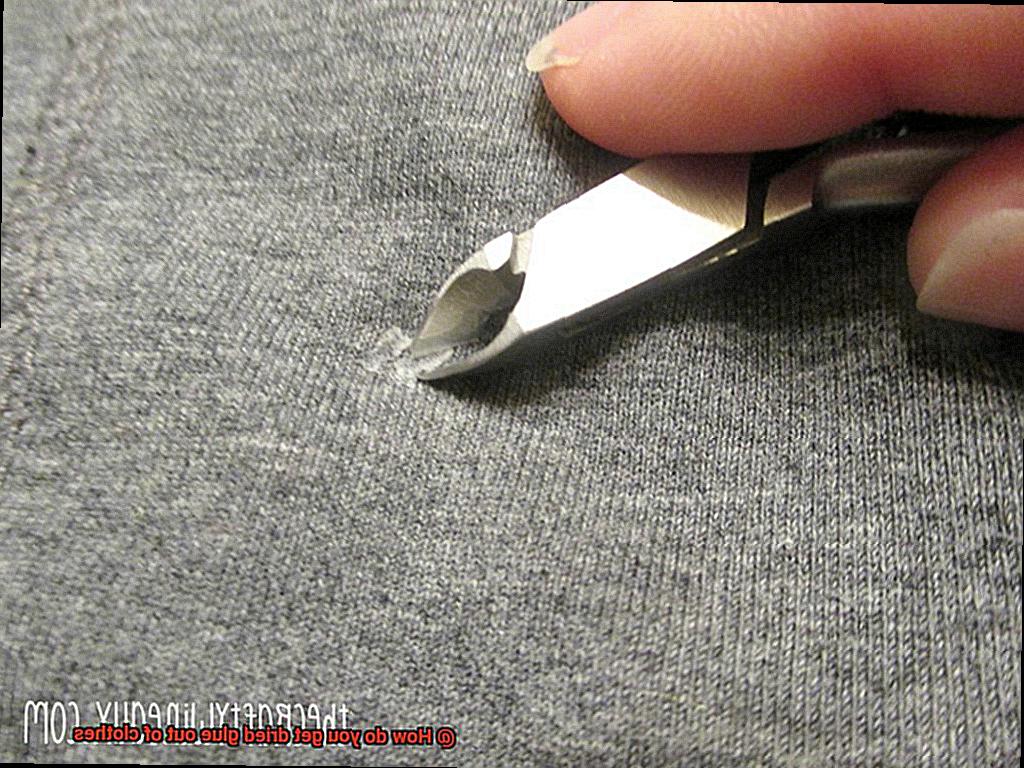
Before embarking on any stain removal mission, it’s crucial to test any cleaning solution on a small, inconspicuous area of the fabric. This precautionary measure ensures that our solutions won’t cause any undesirable damage or discoloration. And don’t forget to consult the care instructions on your clothing labels – they hold valuable information that can guide you on your quest.
Applying Vinegar or Rubbing Alcohol
When it comes to removing dried glue from clothes, vinegar and rubbing alcohol are two household items that can come to your rescue. These substances have properties that can break down and dissolve the glue, making it easier to remove from the fabric.
Vinegar, a mild acid known for its cleaning properties, can be used to remove various stains and residues, including dried glue. To use vinegar, create a solution by diluting it with water. Mix equal parts vinegar and water in a bowl or spray bottle.
Place a clean cloth or sponge underneath the affected area to protect the rest of the fabric. Dip another clean cloth or sponge into the vinegar solution and gently dab it onto the glue. Let the vinegar sit on the glue for a few minutes to help break it down. Then, take a soft-bristled brush or an old toothbrush and gently scrub the glue in circular motions until it starts loosening and coming off.
If vinegar doesn’t do the trick, rubbing alcohol is another option. Rubbing alcohol, also known as isopropyl alcohol, is a solvent that can dissolve many types of adhesives, including dried glue.
However, it should only be used on washable fabrics as it may cause discoloration or damage delicate materials. Dampen a cloth or sponge with rubbing alcohol and gently dab it onto the glue.
Allow the rubbing alcohol to penetrate the glue for a few minutes. Then, use a soft-bristled brush or an old toothbrush to scrub the glue in circular motions until it dissolves and comes off.
After successfully removing the dried glue, follow the care instructions on the garment to wash it properly and remove any residue from vinegar or rubbing alcohol.
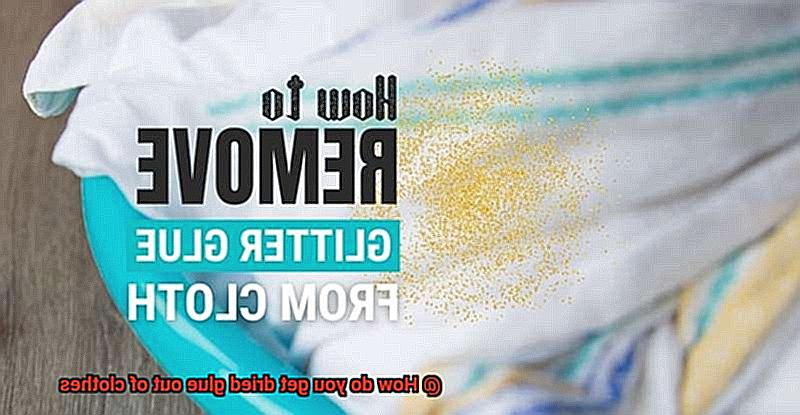
Using Acetone or Nail Polish Remover
Using acetone or nail polish remover can be a helpful solution for removing dried glue from clothes. However, it is important to understand the advantages and disadvantages of these products, as well as how to use them safely.
Advantages of Using Acetone or Nail Polish Remover:
- Effective at Dissolving Glue: Acetone and nail polish remover are powerful solvents that can effectively break down the bonds of many types of glue. This makes them highly effective for removing dried glue stains from clothes.
- Widely Available: Acetone and nail polish remover are readily available at most drugstores, beauty supply stores, and supermarkets. They can be easily purchased without the need for any special permissions or licenses.
- Cost-Effective: Acetone and nail polish remover are relatively inexpensive compared to other cleaning products. A small bottle can be used for multiple applications, making them a cost-effective option for removing glue stains.
Disadvantages of Using Acetone or Nail Polish Remover:
- Potential Damage to Fabrics: Acetone is a strong solvent that can cause damage or discoloration to certain fabrics. It is important to test these products on a small, inconspicuous area of the fabric before applying them to the entire stained area.
- Strong Odor: Acetone has a strong odor that some people may find unpleasant. When using acetone, it is recommended to work in a well-ventilated area to minimize exposure to the odor.
- Safety Concerns: Acetone and nail polish remover should be used with caution. They should not come into contact with the skin or eyes, as they can cause irritation or burns. Additionally, acetone should not be ingested or inhaled, as it can be harmful.
Tips for Using Acetone or Nail Polish Remover Safely:
- Test on a Small Area: Before applying acetone or nail polish remover to the entire stained area, test it on a small, inconspicuous area of the fabric. Wait a few minutes to check for any adverse reactions such as discoloration or damage.
- Work in a Well-Ventilated Area: Acetone has a strong odor, so it is important to work in a well-ventilated area to minimize exposure to the odor. Open windows or use fans to improve air circulation.
- Avoid Contact with Skin and Eyes: Wear gloves to protect your hands when handling acetone or nail polish remover. If any product comes into contact with your skin or eyes, rinse immediately with water.
- Do Not Use on Certain Fabrics: Acetone should not be used on fabrics such as acetate, rayon, or fabrics labeled as dry-clean only, as it may cause damage.
Pre-Treating with Laundry Stain Remover
Accidents happen, and when glue finds its way onto our clothes, panic sets in. But fear not. Pre-treating with a laundry stain remover is the secret weapon you need to banish those stubborn dried glue stains. In this comprehensive guide, we’ll explore the benefits of pre-treating with a laundry stain remover and provide you with step-by-step instructions to ensure success. So grab your stain remover and get ready to conquer those pesky stains.
Effective Stain Removal:
Laundry stain removers are specifically formulated to tackle tough stains, including glue. Their powerful ingredients work diligently to penetrate the fabric fibers and break down even the most stubborn adhesive marks. By pre-treating with a stain remover, you increase your chances of successfully removing the glue stain, saving your favorite garments from permanent damage.
Versatility:
One of the greatest benefits of using a laundry stain remover is its versatility. These products are suitable for use on various fabric types, making them a reliable solution for different clothing items. Whether it’s cotton, polyester, or delicate materials like silk, a quality stain remover can be safely applied without compromising the fabric’s integrity.
Ease of Application:
Pre-treating with a laundry stain remover is a straightforward process that anyone can master. Begin by scraping off any excess glue with a blunt knife or spoon. Then, apply a small amount of stain remover directly onto the stained area and gently rub it into the fabric using your fingers or a soft brush. Allow the stain remover time to work its magic before rinsing with cold water. The simplicity of this process makes it accessible to everyone, ensuring stress-free stain removal.
Time-Saving Solution:
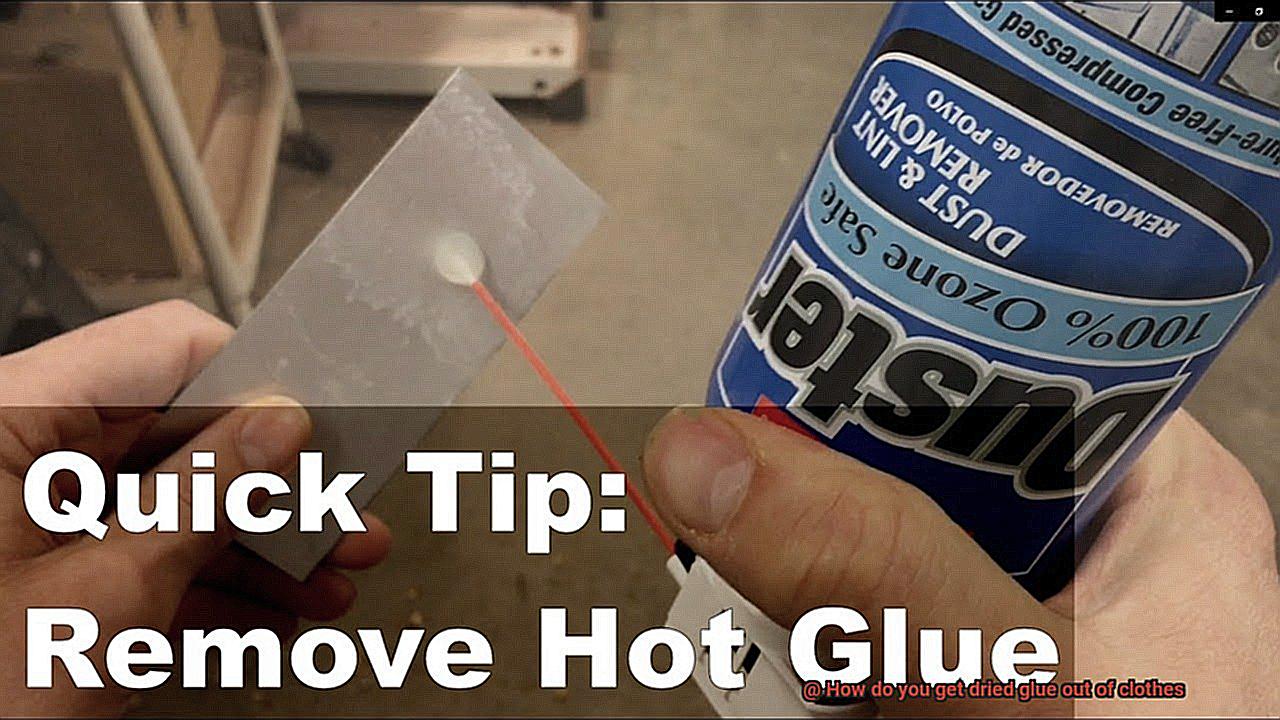
By pre-treating with a laundry stain remover, you save valuable time and effort in the long run. Traditional methods of stain removal often involve multiple wash cycles or soaking, prolonging the time required to eliminate the stain. However, with a stain remover, you can target the specific area of concern, allowing you to swiftly remove the glue stain and move on with your day.
Preserving Garment Lifespan:
When you pre-treat with a laundry stain remover, you not only remove the unsightly glue stain but also extend the lifespan of your clothes. By quickly addressing stains, you avoid the risk of them becoming set-in or permanent. This proactive approach ensures that your garments remain in pristine condition, ready to be enjoyed for years to come.
Seeking Professional Help
Seeking professional help is often the best course of action when it comes to removing dried glue from clothes. While DIY methods may work for some stains, there are situations where the expertise and resources of professionals are necessary. Here are a few types of professionals who can come to your rescue:
- Dry cleaners: These experts have years of experience in dealing with all sorts of stains, including dried glue. They have specialized equipment and knowledge to carefully examine your fabric and determine the best course of action. Make sure to choose a reputable dry cleaner who has experience with glue stains.
- Textile specialists: If you’re dealing with delicate fabrics or expensive garments, consulting a textile specialist is a wise move. These professionals have in-depth knowledge about different fabrics and their cleaning requirements. They can provide tailored advice on how to remove the dried glue without causing any damage.
- Conservators: If your glued garment holds sentimental or monetary value, seeking help from a professional conservator might be worth considering. These trained experts specialize in preserving and restoring textiles. They possess extensive knowledge of various cleaning techniques that can effectively remove dried glue while maintaining the garment’s integrity.
When seeking professional help, be sure to inform them about the nature of the stain and provide any relevant information about the fabric. This will help them devise the most suitable approach for removing the glue.
inY7P4fIZGg” >
Conclusion
Removing dried glue from clothes can be a pesky task, but fear not.
There are effective methods to salvage your beloved garments. With a few simple steps and some handy household items, you can bid farewell to that stubborn glue stain.
Don’t let a sticky situation ruin your day – take action and restore your clothes to their former glory.

